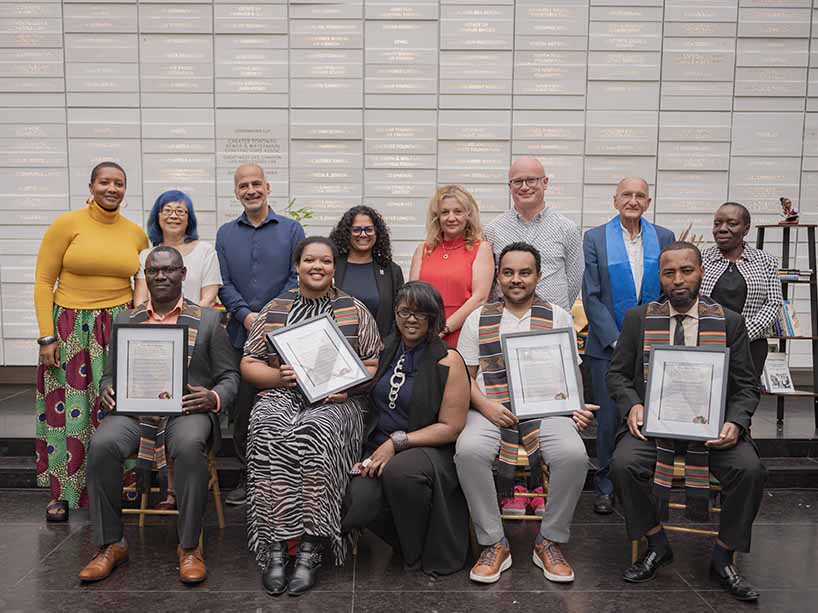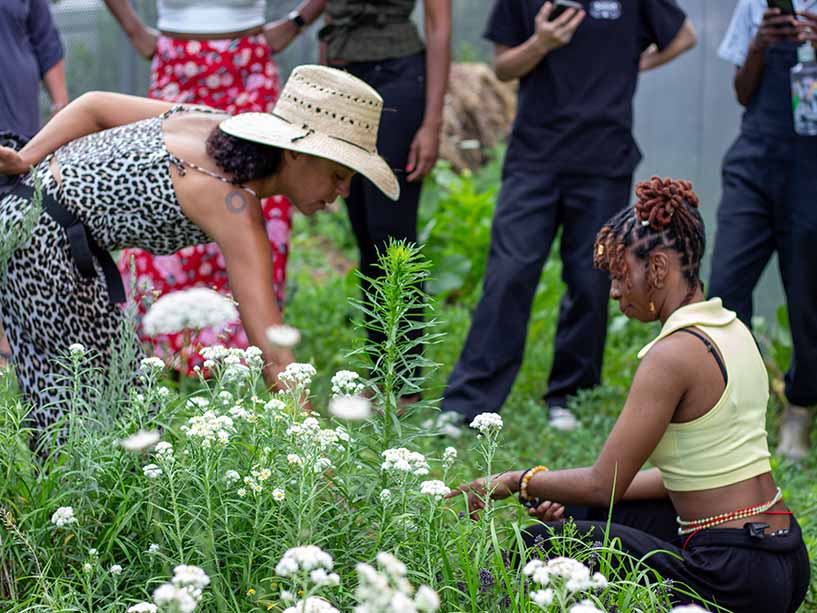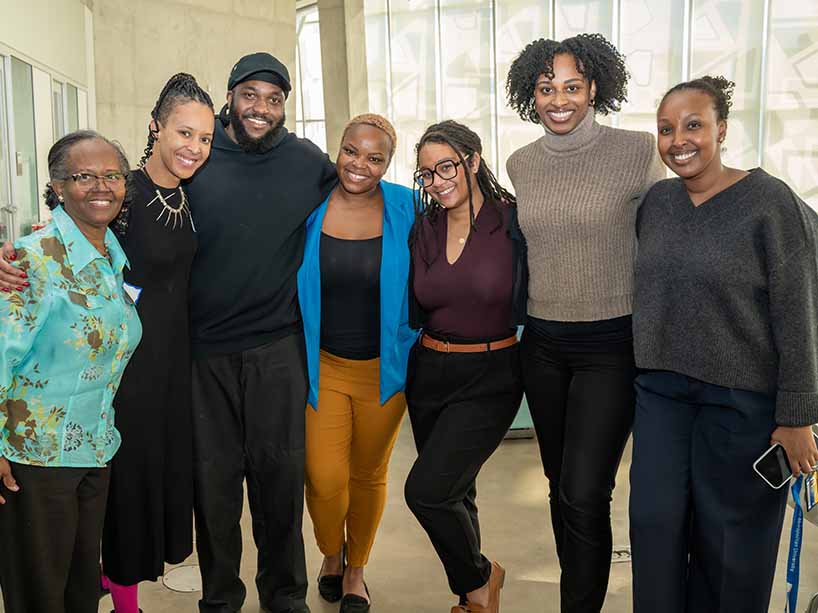10 Learnings from Three Years of Confronting Anti-Black Racism

Nikki Waheed at the Alan Shepard Equity, Diversity and Inclusion Awards (Alyssa K. Faoro, 2024).
Last year marked the third anniversary of the groundbreaking Anti-Black Racism Climate Review released by the Office of the Vice-President, Equity and Community Inclusion. The report highlighted 14 tangible recommendations to respond to the experiences of Black students, staff and faculty at the university.
To commemorate this milestone and weave together the story of the university’s recent efforts to confront anti-Black racism, the Presidential Implementation Committee to Confront Anti-Black Racism (PICCABR) is releasing the Cultivating Black Flourishing Report.
The report not only documents progress to date and charts the road ahead, it offers an opportunity to reflect on how our understanding of the work has evolved along the way; and thus, has also captured ongoing efforts to confront anti-Black racism at the university beyond the work of PICCABR.
Here are 10 key insights we’ve gained since the publication of the Anti-Black Racism Campus Climate Review Report:
1. Confronting anti-Black racism is not enough; we need Black flourishing
Too often, Black experiences are only considered in the context of racial trauma. Shortly into the implementation of the recommendations, the PICCABR started to look beyond a commitment to challenging anti-Black racism and towards a vision where Black people can thrive in an environment that protects their joy and belonging.
In the report, we invite you to learn about Black flourishing, a guiding principle of the PICCABR's work. Building on the Scarborough Charter (external link) signed by President Lachemi in 2022, a focus on Black flourishing means that the university isn't just addressing the effects of anti-Black racism. Rather, we remain committed to cultivating the environment and conditions needed for Black students, faculty and staff to thrive within the institution and beyond.
2. Black experiences must remain at the centre
Though efforts to cultivate Black flourishing remain a collective responsibility, they must continue to respond to the evolving experiences of Black students, faculty and staff, especially those navigating multiple compounding social barriers.
In the report, we invite you to learn how the Black Student Advisory Committee, composed of dedicated Black students representing various student groups, published the (PDF file) Review of Recommendations Report in November 2021. The report, created by committee members and Student Affairs staff, offered tangible student-led insights that ultimately informed the implementation of all 14 recommendations.

Students Sonnet Hines and Sara Eyre at the Black Excellence Mixer (2024).
3. What you water will grow
When enabling environments are created for Black students, staff, faculty and other stakeholders to excel, new possibilities for the future emerge.
In the report, we invite you to learn how the Black Scholarship Institute, based in the Faculty of Community Services, champions the work of Black scholars and works to embed Afro-centric knowledge and knowledge production across TMU.
4. Talents grow on pathways, not through pipelines
Systemic barriers contribute to the under-representation and gradual loss of Black students, faculty and staff in academia, often referred to as a “leaky pipeline”.
In the report, we invite you to learn how the Postdoctoral Fellowships for Black Scholars program, housed within the Yeates School of Graduate and Postdoctoral Studies and funded through the PICCABR and the Office of the Provost, invests in Black scholars to build capacities of prospective Black faculty. This will not only serve to embed Black and Afro-centric knowledge throughout the university, it can fundamentally alter the Canadian academy in years to come.

PICCABR executive co-chairs and chairs, Black fellows and their supervisors at the launch of the Black Postdoctoral Fellowship (Alyssa K. Faoro, 2023).
5. If you want to go far, go together
Confronting anti-Black racism necessitates collective commitment, ongoing consultation and widespread collaboration.
In the report, we invite you to learn how the PICCABR’s work was led by over 50 dedicated individuals across the university, encompassing synergies between the Office of the Vice-President, Equity and Community Inclusion, the Office of the Vice-Provost, Students, the Office of the Vice-Provost, Faculty Affairs, and Human Resources. The implementation and impact of the 14 recommendations is a testament to the work of dozens of teams, departments, schools and faculties.
6. Data, data, data!
Data enables the community to identify patterns and trends to know where progress is being made and where the university is falling short.
In the report, we invite you to learn about the Talent Acquisition Centre of Expertise, housed in Human Resources, and how they are implementing Diversity Self-ID data at job applications. This data, made available through the Office of the Vice-President, Equity and Community Inclusion’s Diversity Self-ID tool, helps to identify representation gaps in the talent pool and establish targeted recruitment strategies.
7. Black flourishing work goes beyond one project and one moment in time
While the Climate Review provided necessary insight into the experiences of Black students, staff and faculty in 2020, it's important to recognize that these experiences are not a monolith. As Black experiences across intersections continue to evolve and bring a new understanding of barriers to light, we need holistic solutions that are nuanced, flexible and responsive to individual needs.
In the report, we invite you to learn about how different teams and departments have and continue to mobilize to address anti-Black racism. There are many initiatives and commitments that are happening outside of and beyond the PICCABR recommendations. These encompass a wide array of activities, such as events, workshops, programs, scholarships, grants, new positions, curricula, research and policies independent of the PICCABR's work.
In the Cultivating Black Flourishing Report, you'll find these sections called essential nutrients, a name chosen to symbolize the role these complementary initiatives play in nourishing the soil and cultivating the conditions for Black flourishing.

Black students and staff looking at plants as part of the Black Sovereignty Initiative in TMU’s Urban Farm (2022).
8. We should build on legacies
Though the PICCABR was specifically established to respond to the Climate Review published three years ago, the initiative builds on existing, and in some cases, long-standing work led by teams and Black students, staff and faculty across the university.
In the report, we invite you to learn how the Office of the Vice-President, Equity and Community Inclusion has celebrated 15 years of the Viola Desmond Awards, honouring Black women, past and present, who are transforming their communities and TMU.
Additionally, the report recognizes the foundational work of Black leaders, such as Akua Benjamin, whose efforts mobilized Black and racialized communities, as well as university stakeholders to actively combat anti-Black racism in institutions across Canada.
9. Diversity is strength when inclusion is action
TMU is home to one of Canada's most diverse student populations. With this diversity comes a responsibility to intentionally build out spaces and places of belonging for Black students and students from other equity-deserving groups.
In the report, we invite you to learn about the Black Student Lounge. Re-launched by the PICCABR’s Student Working Group, the lounge provides Black students with a space to recharge, be in community and feel a sense of belonging at the university. Find out more about the Black Excellence Committee, a cross-campus collaboration amongst several different departments, which hosts several Black-centred initiatives to promote belonging and intergenerational networks, such as the Black Excellence Graduation Celebration and Black Excellence Mixer.

Black Excellence Committee at the Black Excellence Mixer (2024).
10. Black flourishing is a journey, not a destination
While noticeable changes have been made since the launch of the Climate Review to respond to Black student, staff and faculty experiences, the journey is far from over.
Systemic change requires sustained institutional investment so that Black flourishing can become woven into the fabric of the university.
In the report, we invite you to learn how the PICCABR transitioned from a project-based to an institutional model in 2023, inviting departments across the university to own the continued implementation of report recommendations.
With this change, the Office of the Vice-President, Equity and Community Inclusion will support the management and oversight of the PICCABR, while the three executive co-chairs, Roberta Iannacito-Provenzano (provost and vice-president, academic; chair of the Faculty Working Group), Saeed Zolfaghari (vice-president, administration and operations; chair of the Staff Working Group) and Tanya De Mello (vice-president, equity and community inclusion; chair of the Student Working Group), will continue to support process leads in responding to the Black student, faculty and staff recommendations.